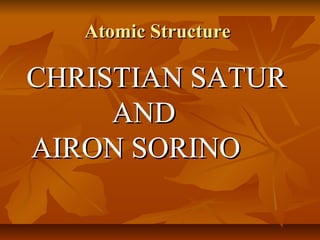
Atomic structure 1 satur
- 1. Atomic Structure CHRISTIAN SATUR AND AIRON SORINO
- 2. What are the 3 major parts of an atom? Proton Neutron Electron
- 3. Draw a diagram showing the location of each part of the atom. http://www.eskom.co.za/nuclear_energy/fuel/fuel.html
- 4. Draw a diagram showing the location of each part of the atom. See more diagrams at: http://www.bmb.psu.edu/courses/bisci004a/chem/basechem.htm
- 5. Draw a diagram showing the location of each part of the atom. http://www.bmb.psu.edu/courses/bisci004a/chem/atoms.jpg
- 6. Draw a Diagram of an Atom
- 7. Draw a diagram showing the charges of each part of the atom.
- 8. Describe Proton Protons are positively charged particles found in the atomic nucleus. Protons were discovered by Ernest Rutherford.. Experiments done in the late 1960's and early 1970's showed that protons are made from other particles called quarks. Protons are made from two 'up' quarks and one 'down' quark.
- 9. Describe Neutron Neutrons are uncharged particles found in the atomic nucleus. Neutrons were discovered by James Chadwick in 1932. Experiments done in the late 1960's and early 1970's showed that neutrons are made from other particles called quarks. Neutrons are made from one 'up' quark and two 'down' quarks.
- 10. Describe Electron Electrons are negatively charged particles that surround the atom's nucleus. Electrons were discovered by J. J. Thomson in 1897. Electrons determine properties of the atom. Chemical reactions involve sharing or exchanging electrons.
- 11. Describe Nucleus The nucleus is the central part of an atom. It is composed of protons and neutrons. The nucleus contains most of an atom's mass. It was discovered by Ernest Rutherford in 1911.
- 12. Describe Quark Believed to be one of the basic building blocks of matter. Quarks were first discovered in experiments done in the late 1960's and early 1970's. Three families of quarks are known to exist. Each family contains two quarks. The first family consists of Up and Down quarks, the quarks that join together to form protons and neutrons. The second family consists of Strange and Charm quarks and only exist at high energies. The third family consists of Top and Bottom quarks and only exist at very high energies.
- 13. Describe Isotope Atoms that have the same number of protons but different numbers of neutrons
- 15. What is the Electron Cloud Model? Model of the atom pictures the electrons moving around the nucleus in a region called an electron cloud. The electron cloud is a cloud of varying density surrounding the nucleus. The varying density shows where an electron is more or less likely to be. Atoms with electrons in higher energy levels have additional electron clouds of different shapes that also show where those electrons are likely to be. For more information, click here: http://regentsprep.org/Regents/physics/phys05/catomodel/cloud.htm
- 16. What is the Electron Cloud Model? Diagram 1:
- 17. What is the Electron Cloud Model? Diagram 2:
